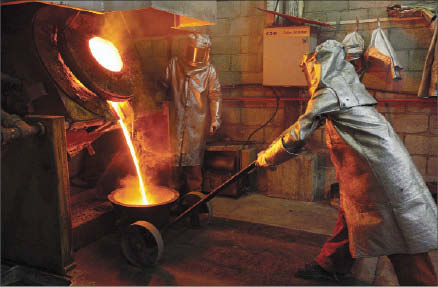Alamos Gold (AGI-T) has posted higher second-quarter profits, despite lower production at its flagship Mulatos gold mine in Mexico’s Sonora state.
The mine generated 36,000 oz. gold, for a 6% decrease from last year’s period. The lower production was caused by a 23% drop in grade, but was partially offset by a higher crusher throughput.
Throughput averaged 15,000 tonnes per day, a 26% increase from the previous quarter. In June, that rate jumped to 16,000 tonnes daily.
A lower solution flow at the mine and a dwindling supply of cyanide also added to the lower production levels.
The company says the start of the rainy season in July has fixed the solution-flow caused by seasonal drought conditions, but adds that the “cyanide is still a bit of an issue,” following a flooding at its cyanide supplier’s facility. Alamos has secured a second supplier for late August, but optimal cyanide application rates are not expected until September. As a result, some production for the third quarter will be completed in the last quarter of 2011.
Despite the setbacks, Alamos reported a quarterly profit of US$15.5 million, a 63% increase from the same period last year on account of higher gold prices.
The miner sold 37,800 oz. gold at an average realized gold price of US$1,504 per oz., racking up US$56.9 million in revenue and US$27.7 million, or US24¢ per share, in cash flow before working capital changes. The cash flow exceeded analysts’ consensus of US22¢ per share, according to a Haywood Securities’ research report.
Alamos also saw better-than-expected cash costs for the quarter at US$355 per oz., excluding royalties.
The company says it continues to look at ways to improve cash costs, and will see if it can trim costs by lowering its power-generating expenses.
For 2011, the producer says it’s on track to generate 145,000 to 160,000 oz. gold, at cash costs between US$365 and US$390 per oz.
Meanwhile, the debt-free company with US$150 million in-hand plans to spend more than US$40 million to enhance its
Mexican mine.
Alamos has set aside US$25 million in cash to develop the high-grade Escondida zone at the Mulatos mine, located in the Salamandra group of concessions, and another US$17.5 million to build a Gekko gravity plant to process ore from Escondida, and other nearby zones. The plant is expected to be ready by year-end. Production from the zone is expected to begin in early 2012.
Apart from development work, the miner has been actively exploring the El Carricito and San Carlos zones, with four rigs.
Previous drilling at El Carricito, which sits 20 km southwest of the Mulatos pit, has so far returned less-than-promising results. Alamos began drilling the zone in late 2010, and its best hole to date carries an interval of 85 metres grading 0.53 gram gold. It hopes to see better results from its ongoing first-phase drilling program, which will end in September.
Recent metallurgical testing shows ore from San Carlos is amenable to gravity separation, and could potentially double the feed for the Gekko plant.
During the second quarter, the company conducted in-fill and step-out drilling at San Carlos, which confirmed the continuity of high-grade mineralization toward the northeast. It also discovered two sub-parallel structures 600 metres from San Carlos’ resource area. Alamos says the new zones are covered by overburden, but are at the same elevation as the existing mineralization. As a result, Alamos is examining the possibility of mining a portion of the zone underground.
In March, the company released an initial reserve estimate at San Carlos. The zone contains 160,000 oz. from 2.6 million tonnes grading 1.89 grams gold.
Reserves at Mulatos stand at 58.5 million tonnes of 1.27 grams gold for 2.4 million contained oz. The mine has a nine-year life.
On the quarterly news, Alamos shares dropped $1.02 to $17.44 per share, within a 52-week trading range of $13.26-$21.65.
Haywood Securities has given the stock a “sector outperform” rating, with a target price of $21.50 per share.
The company also has the Agi Dagi and Kirazli gold projects in northwestern Turkey.


Be the first to comment on "Alamos is on the move"